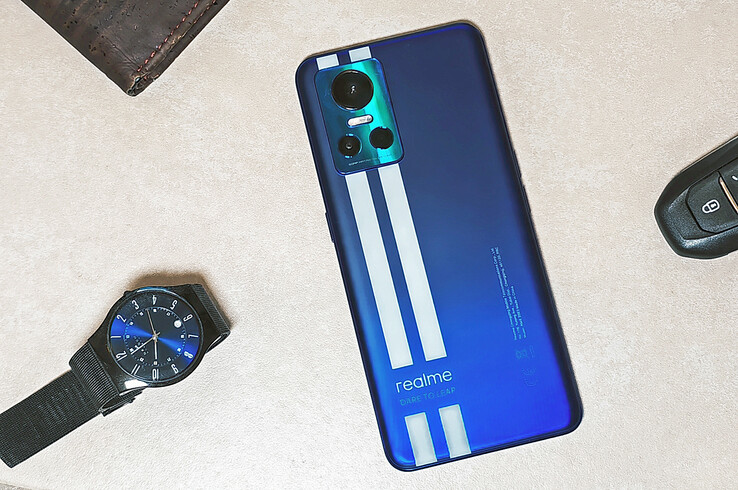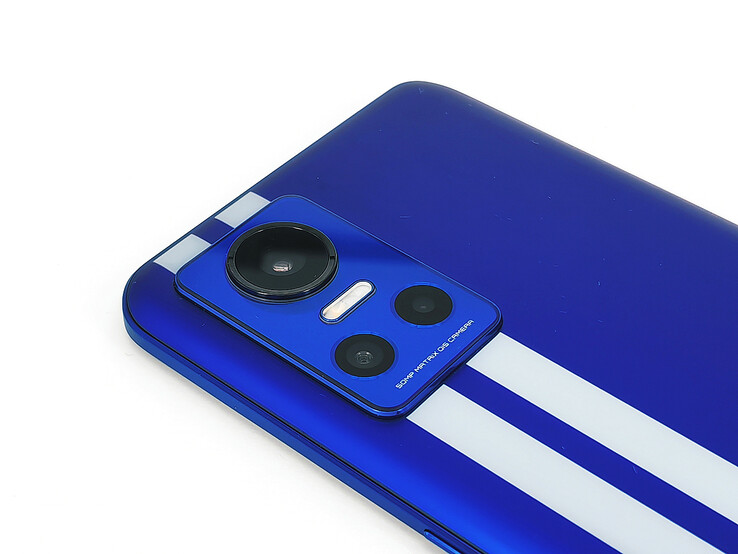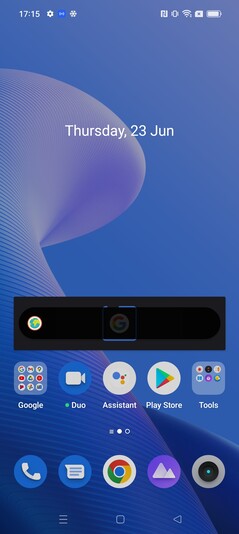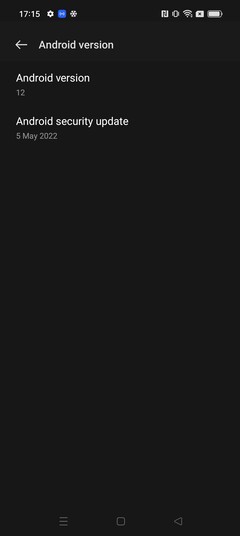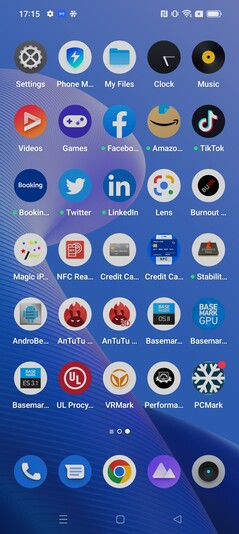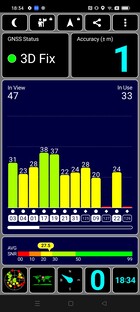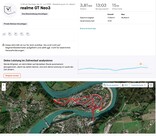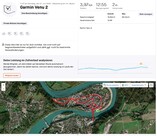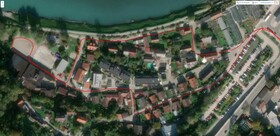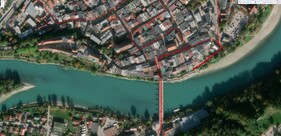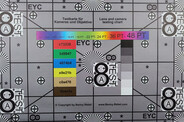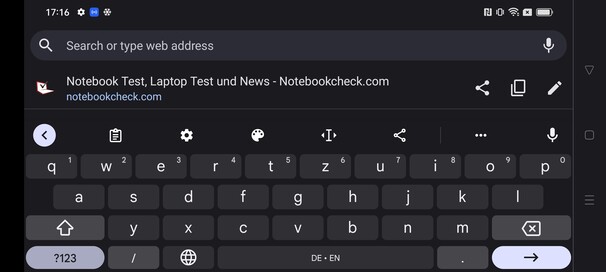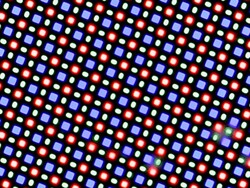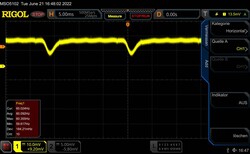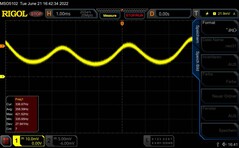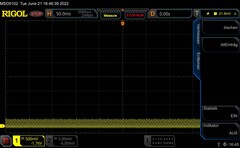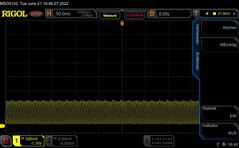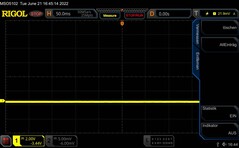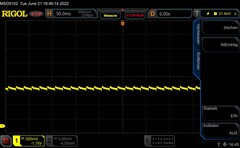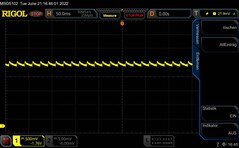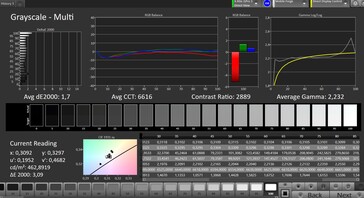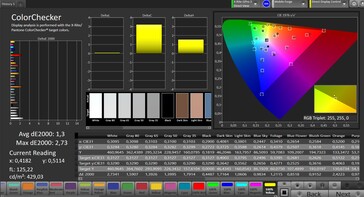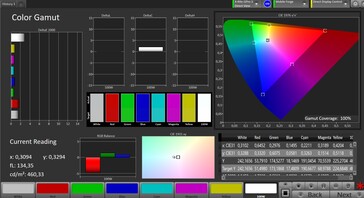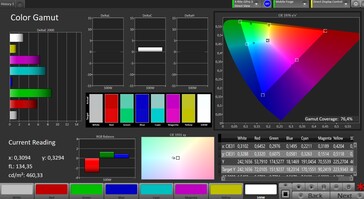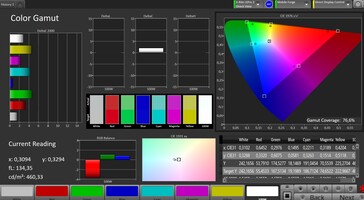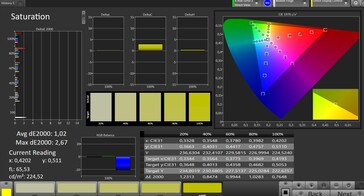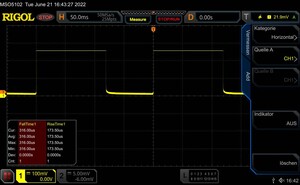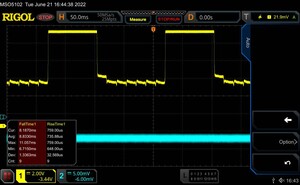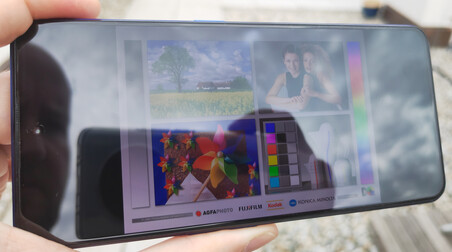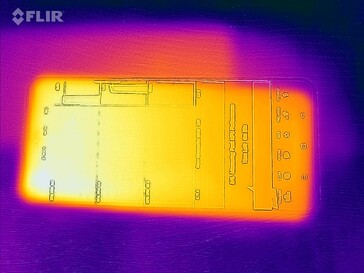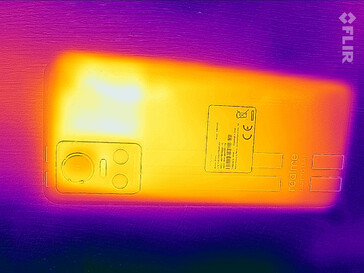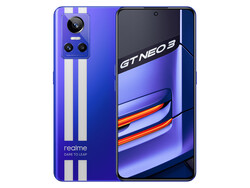realme GT Neo 3 review: Innovative smartphone with fast charging technology
Those who infer that the realme GT Neo 3 is the successor of the GT Neo 2 in view of the naming are bound to ask themselves when looking at the price: Why is it so much more expensive then?
As a matter of fact, realme is expanding its portfolio of phones significantly this year, so it is the realme GT Neo 3T that should be seen as the direct successor of the GT Neo 2, while the GT Neo 3 shifts into higher (price) territory with a new SoC and some interesting equipment details.
Our in-depth review will examine all details of the smartphone. In particular, we'll shed light on just how well the new processor performs, what the dedicated display chip brings to the table, and how fast the new 150-watt charging technology actually is. So, in the spirit of the racing design: On your marks! Get set! Go!
Possible Competitors in Comparison
Rating | Date | Model | Weight | Drive | Size | Resolution | Price |
|---|---|---|---|---|---|---|---|
| 86.3 % v7 (old) | 06 / 2022 | Realme GT Neo 3 Dimensity 8100, Mali-G610 MP6 | 188 g | 256 GB UFS 3.1 Flash | 6.70" | 2412x1080 | |
| 85.2 % v7 (old) | 12 / 2021 | Realme GT Neo 2 SD 870, Adreno 650 | 200 g | 256 GB UFS 3.1 Flash | 6.62" | 2400x1080 | |
| 87.4 % v7 (old) | 11 / 2021 | Google Pixel 6 Tensor, Mali-G78 MP20 | 207 g | 128 GB UFS 3.1 Flash | 6.40" | 2400x1080 | |
| 88.1 % v7 (old) | 03 / 2022 | Xiaomi 12X SD 870, Adreno 650 | 176 g | 256 GB UFS 3.1 Flash | 6.28" | 2400x1080 | |
| 88.8 % v7 (old) | 02 / 2022 | Samsung Galaxy S21 FE 5G SD 888 5G, Adreno 660 | 177 g | 128 GB UFS 3.1 Flash | 6.40" | 2340x1080 |
Case: Inspired by racing legends
We have already seen the GT Neo 2 attempt to make a shot at orignality with its neon green color case. For the realme GT Neo 3, potential buyers can opt for a simple asphalt black color, but this would detract from the smartphone's special appeal; the bright blue or white color variants with their racing stripes are much more interesting. According to the manufacturer, they draw inspiration from the legendary car racing of the 1960s.
The back is made of matte anti-glare glass which leaves no visible fingerprints. On the front, the screen is protected by Gorilla Glass 5, which is unfortunately no longer the latest version of the protective glass. In contrast, the Google Pixel 6 or the Xiaomi 12X are equipped with the much more resilient Gorilla Glass Victus 6.
Unfortunately, the realme GT Neo 3 creaks when twisted, which reduces our overall impression of quality. Otherwise the smartphone is stable and withstands pressure quite well. It also feels good to use and is quite light for its size at 188 grams.
There is no IP certification, so customers cannot be certain that their smartphone will survive a swim in water.
Equipment: Savings option with the realme GT Neo 3
The manufacturer has made an unusual decision in terms of variants to choose from. These usually only differ in terms of RAM, but there is another difference in the realme GT Neo 3 (in addition to less RAM in the cheap model): The cheaper GT Neo 3 charges with only 80 watts, while the more expensive variant pumps the battery full with a maximum of 150 watts.
Prices are as follows:
- realme GT Neo 3 (80 watts) 8 GB RAM / 256 GB: Depends on country of purchase. In Germany: 599.99€
- realme GT Neo 3 (150 watt) 12 GB RAM / 256 GB Depends on country of purchase. In Germany: 699.99€
Buyers thus have the opportunity to save if the cheaper model suits their needs.
Another nice feature of is realme smartphone is the new Bluetooth 5.3 function, which is supposed to improve connection quality and battery life of connected devices, among other things.
NFC is also available, of course, and realme promises particularly a large coverage area on the back. This is confirmed in a short test. However, NFC does not work all over the GT Neo 3 nor from every angle, as the manufacturer specifies on its website.
Software: realme smartphone with short update promise
realme UI 3 is installed on the smartphone and the user interface is based on Android 12. However, it looks like Android 11 in many areas - the new design that Google introduced has not yet been incorporated in the system interface, aside from Google's own apps. This also helps you to find your way around if you previously had an older Android phone.
Unlike the realme GT 2 Pro, the GT Neo 3 will only receive 2 Android updates and 3 years of security patches. At the time of writing, the security patch installed is from May 2022 and thus no longer up to date.
There is a DRM-L1 certification, so viewing HD content in streaming services is possible without problems.
Communication & GNSS: Rapidly connected
The realme GT Neo 3 comes with WiFi 6 and can thus easily keep up with comparable smartphones in terms of WLAN transfer rates. The SoC would even support WiFi 6E, but realme does not enable this feature.
According to our tests, a gigabyte connection cannot be fully utilized, but you can still make good use of it. We used our Asus ROG AXE11000 reference router for testing.
The data transfer works at relatively stable speeds, but there are occasional drops in reception.
In terms of mobile connectivity, the GT Neo 3 does not have to shy away from top competing smartphones either. 5G NSA and SA are included, as well as a large number of 4G frequencies, so this should suffice for mobile internet in most countries around the world.
During testing, we also repeatedly check the reception quality in the 4G network. The realme phone is on similar level to other high-end phones and delivers good signal quality, whether in buildings or narrow alleys.
| Networking | |
| iperf3 receive AXE11000 | |
| Samsung Galaxy S21 FE 5G | |
| Realme GT Neo 3 | |
| Average of class Smartphone (52 - 1857, n=171, last 2 years) | |
| Xiaomi 12X | |
| iperf3 transmit AXE11000 | |
| Realme GT Neo 3 | |
| Xiaomi 12X | |
| Samsung Galaxy S21 FE 5G | |
| Average of class Smartphone (49.8 - 1828, n=171, last 2 years) | |
| iperf3 transmit AX12 | |
| Realme GT Neo 2 | |
| Google Pixel 6 | |
| iperf3 receive AX12 | |
| Google Pixel 6 | |
| Realme GT Neo 2 | |
Localization of the smartphone outdoors is relatively quick, lasting a few seconds before the location is pinpointed with an accuracy of up to 1 meter. This precise positioning is enabled by numerous satellites that are found quickly, aided by the SBAS auxiliary system.
For real world testing, we went for a bike ride and took the Garmin Venu 2 smartwatch with us for comparison. Here the GT Neo 3 performs rather poorly: the smartphone barely recognizes the loop we make during riding and cuts across through buildings several times in the narrow streets of the old town. Overall, you should not rely too much on the localization accuracy when in motion.
Telephony & Voice Quality: Mostly clear and intelligble
realme has installed Google's phone app, so Android users should be able to quickly come to grips with the smartphone.
Voice quality via the earpiece is good, and the microphone picks up our voice clearly. We can also communicate well via the speaker and the hands-free microphone, but the realme caller should not speak too quietly or the receiver will not hear anything.
Cameras: Still no hybrid zoom
A Sony IMX766 with optical image stabilization is used as the camera's main sensor. It has a native resolution of 50 megapixels, but usually only takes 12-megapixel photos and uses the larger pixels for higher light output.
The image quality is decent, but bright areas occasionaly overshine, and the brightness could be a bit better in other areas. In low light and high contrasts, there is good detail display, but insufficient lightning in dark areas.
Somewhat annoying is the fact that the camera still does not offer hybrid zoom between the wide-angle and main camera; you can only switch directly between the lenses. Otherwise the wide-angle lens corrects the distortion quite well, but there is a clear loss of detail when zooming in.
Videos can be recorded at a maximum of 4K and 60 fps, and you have to decide on the desired lens before recording. The image quality, as well as the response of the autofocus and exposure compensation, are impeccable.
Image comparison
Choose a scene and navigate within the first image. One click changes the position on touchscreens. One click on the zoomed-in image opens the original in a new window. The first image shows the scaled photograph of the test device.
Hauptkamera BlumeHauptkamera UmgebungHauptkamera Low LightWeitwinkelkameraIn the lab, we took another look at the camera's performance under controlled conditions. Here, we see good contrast reproduction as well as clean color transitions. However, the general image sharpness could be a bit higher.
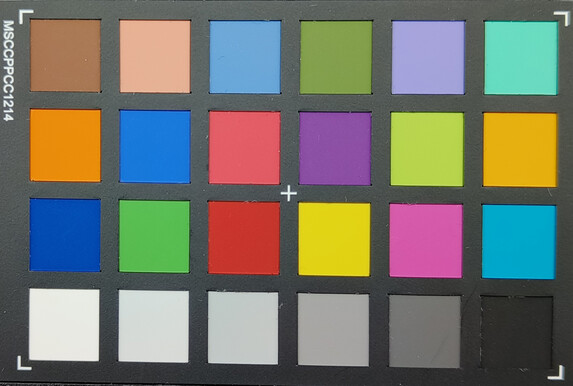
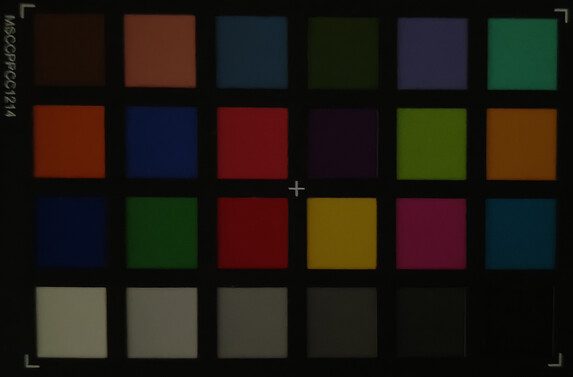
Accessories & Warranty: Charger included
Buyers receive a charger for the specified charging power, a USB cable, a SIM tool and a silicone bumper. realme currently does not offer special accessories for the smartphone on its website.
The warranty is 24 months when purchased in the EU. This may differ in other countries and regions.
Input Devices & Operation: Heart rate measurement possible
The touchscreen responds quickly and reliably to inputs. Thanks to the 120 Hz display, input works even smoother. You have a choice between 120 Hz and 60 Hz, or you can choose to activate dynamic adjustment.
The fingerprint sensor responds very promptly and recognizes our prints reliably. However, it is placed very low on the case, meaning that you sometimes have to fully grasp the thumb around the edge for it to work.
Apps such as banking software and private files can be unlocked with the fingerprint sensor, which can also be used easily to measure the heart rate.
Face recognition is also possible, but only via a comparatively unreliable software solution.
Display: Very accurate colors
The screen uses a resolution of 2412 x 1080, can display up to 1.07 billion colors and is also HDR-capable. We measured up to 759 cd/m² brightness in testing with the spectrophotometer. This is a good value, but some smartphones like the Xiaomi 12X are clearly in front. Without the brightness sensor, the realme smartphone reachs a maximum possible brightness of 500 cd/m².
We observed the usual PWM flickering that is typical for OLED screens, which is particularly visible at around 50% brightness. In the developer settings, there is the option to activate DC dimming, which significantly reduces the flickering effects, but can also lead to color changes at low brightness.
| |||||||||||||||||||||||||
Brightness Distribution: 97 %
Center on Battery: 759 cd/m²
Contrast: ∞:1 (Black: 0 cd/m²)
ΔE ColorChecker Calman: 1.3 | ∀{0.5-29.43 Ø4.8}
ΔE Greyscale Calman: 1.7 | ∀{0.09-98 Ø5.1}
100% sRGB (Calman 2D)
Gamma: 2.232
CCT: 6616 K
| Realme GT Neo 3 AMOLED, 2412x1080, 6.7" | Realme GT Neo 2 AMOLED, 2400x1080, 6.6" | Google Pixel 6 OLED, 2400x1080, 6.4" | Xiaomi 12X OLED, 2400x1080, 6.3" | Samsung Galaxy S21 FE 5G Dynamic AMOLED 2X, 2340x1080, 6.4" | |
|---|---|---|---|---|---|
| Screen | -108% | -6% | 23% | -10% | |
| Brightness middle (cd/m²) | 759 | 767 1% | 805 6% | 910 20% | 758 0% |
| Brightness (cd/m²) | 758 | 767 1% | 805 6% | 908 20% | 758 0% |
| Brightness Distribution (%) | 97 | 97 0% | 98 1% | 97 0% | 99 2% |
| Black Level * (cd/m²) | |||||
| Colorchecker dE 2000 * | 1.3 | 3.47 -167% | 1.4 -8% | 0.8 38% | 1.5 -15% |
| Colorchecker dE 2000 max. * | 2.73 | 9.23 -238% | 3.7 -36% | 1.8 34% | 3.1 -14% |
| Greyscale dE 2000 * | 1.7 | 5.9 -247% | 1.8 -6% | 1.3 24% | 2.3 -35% |
| Gamma | 2.232 99% | 2.275 97% | 2.29 96% | 2.25 98% | 2.06 107% |
| CCT | 6616 98% | 7800 83% | 6507 100% | 6414 101% | 6378 102% |
* ... smaller is better
Screen Flickering / PWM (Pulse-Width Modulation)
| Screen flickering / PWM detected | 359 Hz | ||
The display backlight flickers at 359 Hz (worst case, e.g., utilizing PWM) . The frequency of 359 Hz is relatively high, so most users sensitive to PWM should not notice any flickering. However, there are reports that some users are still sensitive to PWM at 500 Hz and above, so be aware. In comparison: 53 % of all tested devices do not use PWM to dim the display. If PWM was detected, an average of 8215 (minimum: 5 - maximum: 343500) Hz was measured. | |||
Messreihe mit fixer Zoomstufe und unterschiedlichen Helligkeitseinstellungen
For color accuracy, we recommend the "natural" profile. The display then delivers a very accurate color reproduction that looks like reality to the human eye. The sRGB color space is covered at 100%.
Display Response Times
| ↔ Response Time Black to White | ||
|---|---|---|
| 5 ms ... rise ↗ and fall ↘ combined | ↗ 3 ms rise | |
| ↘ 2 ms fall | ||
| The screen shows very fast response rates in our tests and should be very well suited for fast-paced gaming. In comparison, all tested devices range from 0.1 (minimum) to 240 (maximum) ms. » 16 % of all devices are better. This means that the measured response time is better than the average of all tested devices (20.3 ms). | ||
| ↔ Response Time 50% Grey to 80% Grey | ||
| 18 ms ... rise ↗ and fall ↘ combined | ↗ 8 ms rise | |
| ↘ 7 ms fall | ||
| The screen shows good response rates in our tests, but may be too slow for competitive gamers. In comparison, all tested devices range from 0.165 (minimum) to 636 (maximum) ms. » 30 % of all devices are better. This means that the measured response time is better than the average of all tested devices (31.8 ms). | ||
Performance: Upper class power
The new MediaTek Dimensity 8100 is used as the SoC in the realme smartphone. Although this does not belong to the absolute top echelon in terms of performance, it is just below it and thus allows for somewhat cheaper smartphones with near-flagship performance.
In fact, the real-world GT Neo 3 proves to be very fast in many benchmarks and even takes first place against competing devices every now and then. However, it does not have a fast single core, so it is forced to give way in apps that do not support multiple processor cores.
| CrossMark - Overall | |
| Average of class Smartphone (187 - 2674, n=129, last 2 years) | |
| Samsung Galaxy S21 FE 5G | |
| Google Pixel 6 | |
| Average MediaTek Dimensity 8100 (764 - 850, n=3) | |
| Realme GT Neo 3 | |
| Xiaomi 12X | |
| AImark - Score v2.x | |
| Xiaomi 12X | |
| Realme GT Neo 3 | |
| Average MediaTek Dimensity 8100 (6367 - 6893, n=2) | |
| Google Pixel 6 | |
| Samsung Galaxy S21 FE 5G | |
The ARM Mali-G610 MP6 as the graphics unit also offers great performance rates and only has to contend with even higher-quality SoCs in very demanding benchmarks.
| 3DMark | |
| Wild Life Extreme Unlimited | |
| Google Pixel 6 | |
| Realme GT Neo 2 | |
| Xiaomi 12X | |
| Realme GT Neo 3 | |
| Samsung Galaxy S21 FE 5G | |
| Wild Life Extreme | |
| Google Pixel 6 | |
| Samsung Galaxy S21 FE 5G | |
| Realme GT Neo 3 | |
| Xiaomi 12X | |
| Realme GT Neo 2 | |
| Wild Life Unlimited Score | |
| Google Pixel 6 | |
| Samsung Galaxy S21 FE 5G | |
| Xiaomi 12X | |
| Realme GT Neo 2 | |
| Realme GT Neo 3 | |
| Wild Life Score | |
| Google Pixel 6 | |
| Samsung Galaxy S21 FE 5G | |
| Xiaomi 12X | |
| Realme GT Neo 2 | |
| Realme GT Neo 3 | |
| GFXBench (DX / GLBenchmark) 2.7 | |
| T-Rex Onscreen | |
| Realme GT Neo 2 | |
| Samsung Galaxy S21 FE 5G | |
| Xiaomi 12X | |
| Google Pixel 6 | |
| Realme GT Neo 3 | |
| 1920x1080 T-Rex Offscreen | |
| Realme GT Neo 3 | |
| Realme GT Neo 2 | |
| Samsung Galaxy S21 FE 5G | |
| Xiaomi 12X | |
| Google Pixel 6 | |
| GFXBench 3.0 | |
| on screen Manhattan Onscreen OGL | |
| Realme GT Neo 2 | |
| Samsung Galaxy S21 FE 5G | |
| Xiaomi 12X | |
| Google Pixel 6 | |
| Realme GT Neo 3 | |
| 1920x1080 1080p Manhattan Offscreen | |
| Realme GT Neo 3 | |
| Realme GT Neo 2 | |
| Samsung Galaxy S21 FE 5G | |
| Xiaomi 12X | |
| Google Pixel 6 | |
| GFXBench 3.1 | |
| on screen Manhattan ES 3.1 Onscreen | |
| Realme GT Neo 2 | |
| Xiaomi 12X | |
| Samsung Galaxy S21 FE 5G | |
| Realme GT Neo 3 | |
| Google Pixel 6 | |
| 1920x1080 Manhattan ES 3.1 Offscreen | |
| Realme GT Neo 3 | |
| Realme GT Neo 2 | |
| Samsung Galaxy S21 FE 5G | |
| Xiaomi 12X | |
| Google Pixel 6 | |
| GFXBench | |
| on screen Car Chase Onscreen | |
| Realme GT Neo 3 | |
| Realme GT Neo 2 | |
| Xiaomi 12X | |
| Samsung Galaxy S21 FE 5G | |
| Google Pixel 6 | |
| 1920x1080 Car Chase Offscreen | |
| Realme GT Neo 2 | |
| Realme GT Neo 3 | |
| Samsung Galaxy S21 FE 5G | |
| Xiaomi 12X | |
| Google Pixel 6 | |
| on screen Aztec Ruins High Tier Onscreen | |
| Samsung Galaxy S21 FE 5G | |
| Realme GT Neo 3 | |
| Google Pixel 6 | |
| Realme GT Neo 2 | |
| Xiaomi 12X | |
| 2560x1440 Aztec Ruins High Tier Offscreen | |
| Samsung Galaxy S21 FE 5G | |
| Google Pixel 6 | |
| Realme GT Neo 2 | |
| Xiaomi 12X | |
| Realme GT Neo 3 | |
| on screen Aztec Ruins Normal Tier Onscreen | |
| Realme GT Neo 3 | |
| Realme GT Neo 2 | |
| Samsung Galaxy S21 FE 5G | |
| Xiaomi 12X | |
| Google Pixel 6 | |
| 1920x1080 Aztec Ruins Normal Tier Offscreen | |
| Realme GT Neo 3 | |
| Realme GT Neo 2 | |
| Samsung Galaxy S21 FE 5G | |
| Xiaomi 12X | |
| Google Pixel 6 | |
Web browsing works at good speeds on the realme smartphone. Our review device falls in the midfield among comparison devices, but still offers fast loading times for websites and usually loads images while scrolling.
| Jetstream 2 - 2.0 Total Score | |
| Average of class Smartphone (13.8 - 387, n=148, last 2 years) | |
| Xiaomi 12X (Chrome 98.0.4758.101) | |
| Google Pixel 6 (Chrome 96) | |
| Average MediaTek Dimensity 8100 (80.5 - 82.5, n=3) | |
| Realme GT Neo 3 (Chrome 103) | |
| Samsung Galaxy S21 FE 5G (Chrome 96) | |
| Speedometer 2.0 - Result 2.0 | |
| Average of class Smartphone (15.2 - 621, n=130, last 2 years) | |
| Google Pixel 6 (Chrome 96) | |
| Realme GT Neo 3 (Chome 103) | |
| Average MediaTek Dimensity 8100 (64.5 - 79.3, n=3) | |
| Xiaomi 12X (Chrome 98.0.4758.101) | |
| Samsung Galaxy S21 FE 5G (Chrome 96) | |
| WebXPRT 3 - Overall | |
| Average of class Smartphone (38 - 380, n=42, last 2 years) | |
| Xiaomi 12X (Chrome 98.0.4758.101) | |
| Samsung Galaxy S21 FE 5G (Chrome 96) | |
| Google Pixel 6 (Chrome 96) | |
| Average MediaTek Dimensity 8100 (101 - 113, n=3) | |
| Realme GT Neo 3 (Chrome 103) | |
| Octane V2 - Total Score | |
| Average of class Smartphone (2228 - 119218, n=196, last 2 years) | |
| Google Pixel 6 (Chrome 96) | |
| Xiaomi 12X (Chrome 98.0.4758.101) | |
| Average MediaTek Dimensity 8100 (33046 - 35255, n=3) | |
| Realme GT Neo 3 (Chrome 103) | |
| Samsung Galaxy S21 FE 5G (Chrome 96) | |
| Mozilla Kraken 1.1 - Total | |
| Samsung Galaxy S21 FE 5G (Chrome 96) | |
| Average MediaTek Dimensity 8100 (1274 - 1447, n=3) | |
| Realme GT Neo 3 (Chrome 103) | |
| Average of class Smartphone (263 - 28190, n=151, last 2 years) | |
| Xiaomi 12X (Chrome 98.0.4758.101) | |
| Google Pixel 6 (Chrome 96) | |
* ... smaller is better
UFS 3.1 enables short load times and works very quickly in the realme GT Neo 3.
| Realme GT Neo 3 | Realme GT Neo 2 | Google Pixel 6 | Xiaomi 12X | Samsung Galaxy S21 FE 5G | Average 256 GB UFS 3.1 Flash | Average of class Smartphone | |
|---|---|---|---|---|---|---|---|
| AndroBench 3-5 | -21% | -50% | -19% | -29% | -9% | 11% | |
| Sequential Read 256KB (MB/s) | 1779 | 1761 -1% | 1546 -13% | 1732 -3% | 1639 -8% | 1742 ? -2% | 2216 ? 25% |
| Sequential Write 256KB (MB/s) | 1421 | 763 -46% | 233.4 -84% | 795 -44% | 760 -47% | 1191 ? -16% | 1821 ? 28% |
| Random Read 4KB (MB/s) | 331 | 281.1 -15% | 126.2 -62% | 291.9 -12% | 245.1 -26% | 286 ? -14% | 295 ? -11% |
| Random Write 4KB (MB/s) | 330 | 260.2 -21% | 190.3 -42% | 279.9 -15% | 211.2 -36% | 318 ? -4% | 339 ? 3% |
Gaming: 60-fps gaming possible
The realme smartphone is capable of up to 120 fps is possible, but this first has to be enabled by the game developer. Therefore, only a maximum of 60 fps was possible in the games we tested. These frame rates were reached in Armajet and PUBG Mobile at low details. Only a maximum of 40 fps was possible in PUBG at high settings. We measured the frame rates with GameBench.
According to realme, the smartphone has its own display chip that can calculate intermediate frames via AI and image analysis, thus allowing games to run even more smoothly. Genshin Impact, for example, is one of the supported games where demanding gamers can have an even smoother scrolling experience.
Emissions: Light throttling
Temperature
The realme smartphone heats up noticeably under load. While temperatures on the surface do not always become critical, they may do so at higher ambient temperatures.
On the other hand, the chip's performance appears to be only minimially affected by the high temperatures: performance initially drops in the 3D Mark Wild Life Stress Test, but increases again to the original level.
(±) The maximum temperature on the upper side is 45 °C / 113 F, compared to the average of 35.2 °C / 95 F, ranging from 21.9 to 247 °C for the class Smartphone.
(±) The bottom heats up to a maximum of 44 °C / 111 F, compared to the average of 33.9 °C / 93 F
(+) In idle usage, the average temperature for the upper side is 25.3 °C / 78 F, compared to the device average of 32.9 °C / 91 F.
3DMark Wild Life Stress Test
| 3DMark | |
| Wild Life Stress Test Stability | |
| Realme GT Neo 3 | |
| Xiaomi 12X | |
| Samsung Galaxy S21 FE 5G | |
| Google Pixel 6 | |
| Wild Life Extreme Stress Test | |
| Realme GT Neo 3 | |
| Xiaomi 12X | |
| Samsung Galaxy S21 FE 5G | |
| Google Pixel 6 | |
Speakers
Stereo speakers are installed in the realme GT Neo 3, with the earpiece serving as a second speaker. The smartphone does not distort sounds even at maximum volume. For full sound, bass is lacking, but the smartphone sounds good overall.
Those wanting to connect an external audio system or headphones can use the USB-C port. Of course, wireless communication via Bluetooth is also possible. All current aptX codecs, LDAC, and LHDC are available.
Realme GT Neo 3 audio analysis
(+) | speakers can play relatively loud (82.5 dB)
Bass 100 - 315 Hz
(-) | nearly no bass - on average 24.8% lower than median
(±) | linearity of bass is average (10.4% delta to prev. frequency)
Mids 400 - 2000 Hz
(±) | higher mids - on average 5.2% higher than median
(+) | mids are linear (5% delta to prev. frequency)
Highs 2 - 16 kHz
(+) | balanced highs - only 1.6% away from median
(+) | highs are linear (2.3% delta to prev. frequency)
Overall 100 - 16.000 Hz
(±) | linearity of overall sound is average (18.6% difference to median)
Compared to same class
» 20% of all tested devices in this class were better, 9% similar, 71% worse
» The best had a delta of 12%, average was 35%, worst was 134%
Compared to all devices tested
» 41% of all tested devices were better, 8% similar, 51% worse
» The best had a delta of 4%, average was 24%, worst was 134%
Samsung Galaxy S21 FE 5G audio analysis
(+) | speakers can play relatively loud (88.9 dB)
Bass 100 - 315 Hz
(-) | nearly no bass - on average 25.8% lower than median
(±) | linearity of bass is average (8.9% delta to prev. frequency)
Mids 400 - 2000 Hz
(±) | reduced mids - on average 6.3% lower than median
(+) | mids are linear (4.2% delta to prev. frequency)
Highs 2 - 16 kHz
(±) | higher highs - on average 5% higher than median
(+) | highs are linear (3.7% delta to prev. frequency)
Overall 100 - 16.000 Hz
(±) | linearity of overall sound is average (19.3% difference to median)
Compared to same class
» 25% of all tested devices in this class were better, 9% similar, 66% worse
» The best had a delta of 12%, average was 35%, worst was 134%
Compared to all devices tested
» 45% of all tested devices were better, 8% similar, 47% worse
» The best had a delta of 4%, average was 24%, worst was 134%
Battery Life: Large battery lasts a long time
Power Consumption
The smartphone is a little more energy-hungry than its rivals under low load. Conversely, it is very economical under load.
Our review device can be charged with up to 150 watts, is ready for several hours of use in a few minutes, and fully charged in less than 30 minutes. Charging should also be very fast with the 80-watt power supply. So if every minute is not important to you, you can comfortably choose the cheaper option.
| Off / Standby | |
| Idle | |
| Load |
|
Key:
min: | |
| Realme GT Neo 3 5000 mAh | Google Pixel 6 4614 mAh | Xiaomi 12X 4500 mAh | Samsung Galaxy S21 FE 5G 4500 mAh | Average MediaTek Dimensity 8100 | Average of class Smartphone | |
|---|---|---|---|---|---|---|
| Power Consumption | 13% | -5% | -6% | -3% | -16% | |
| Idle Minimum * (Watt) | 1.1 | 0.68 38% | 0.75 32% | 1.01 8% | 1.087 ? 1% | 0.859 ? 22% |
| Idle Average * (Watt) | 1.5 | 1 33% | 1.88 -25% | 1.5 -0% | 1.77 ? -18% | 1.424 ? 5% |
| Idle Maximum * (Watt) | 2.1 | 1.02 51% | 1.94 8% | 1.6 24% | 2 ? 5% | 1.597 ? 24% |
| Load Average * (Watt) | 3.8 | 5.39 -42% | 4.99 -31% | 5.54 -46% | 3.82 ? -1% | 7.22 ? -90% |
| Load Maximum * (Watt) | 7.8 | 9 -15% | 8.66 -11% | 9.16 -17% | 7.9 ? -1% | 11.1 ? -42% |
* ... smaller is better
Power Consumption: Geekbench (150 cd/m²)
Power Consumption: GFXBench (150 cd/m²)
Battery Life
The large 5,000 mAh battery is fantastic. The smartphone achieves good runtimes, such as 16:29 hours in our WLAN test. At the same time, however, there are competing smartphones in every testing scenario that last a little longer despite a weaker battery.
Nevertheless, the realme GT Neo 3 offers very good runtimes in everyday use and can even survive two workdays of normal use.
| Realme GT Neo 3 5000 mAh | Realme GT Neo 2 5000 mAh | Google Pixel 6 4614 mAh | Xiaomi 12X 4500 mAh | Samsung Galaxy S21 FE 5G 4500 mAh | |
|---|---|---|---|---|---|
| Battery runtime | -3% | -13% | 4% | -18% | |
| Reader / Idle (h) | 40.5 | 33.7 -17% | 35.3 -13% | 23.8 -41% | |
| H.264 (h) | 20.1 | 20.3 1% | 23 14% | 15.6 -22% | |
| WiFi v1.3 (h) | 16.5 | 16 -3% | 10.5 -36% | 17.1 4% | 9.9 -40% |
| Load (h) | 4.9 | 4.9 0% | 5.4 10% | 6.5 33% |
Pros
Cons
Verdict: Good, but not all promises are kept
The realme GT Neo 3 comes with many innovations. Some are nice gimmicks, such as the option of measuring the heartrate via the fingerprint sensor. Others, such as the increased response range of the NFC chip, go virtually unnoticed in everyday use, and the dedicated display chip unfortunately only brings real advantages in certain games.
What remains is a smartphone with a sleek design and good benchmark values at a reasonable price. The camera takes decent pictures but is not quite on the level of high-end phones, as it lacks hybrid zoom, for example.
The lower price also comes at the cost of missing features such as wireless charging, IP certification, a more stable glass display and WiFi 6E. Moreover, other manufacturers are clearly ahead in terms of software updates, and GPS tracking accuracy is not top level either.
The realme GT Neo 3 is a swift and stylish upper-class smartphone that does not quite obtain a top rating due to some weaknesses.
Positive aspeccts of the realme GT Neo 3 include its great, color-accurate AMOLED display. Even though the DC dimming function is a somewhat hard to find, this can nonetheless be activated with a bit of know-how. The memory is lightning fast and battery runtimes are solid overall. Since the charging times are very fast, the real-world GT Neo 3 is a well-rounded smartphone overall whose weaknesses should nonetheless be carefully examined before purchase.
The Google Pixel 6 offers a tougher display glass and wireless charging, but is much heavier. The realme GT Neo 2 predecessor offers less performance and slower charging, but is also much cheaper.
Price and Availability
Since the realme GT Neo 3 was only launched very recently, and due to current supply chain issues around the globe, the smartphone may not be immediately available for purchase in your country. Readers are therefore advised to regularly check via Google or Amazon for availability.
Amazon UK offers the 150 watt variant with 12 GB RAM and 256 storage space for £599.00 in Asphalt Black or Nitro Blue.
Realme GT Neo 3
- 08/30/2022 v7 (old)
Florian Schmitt




